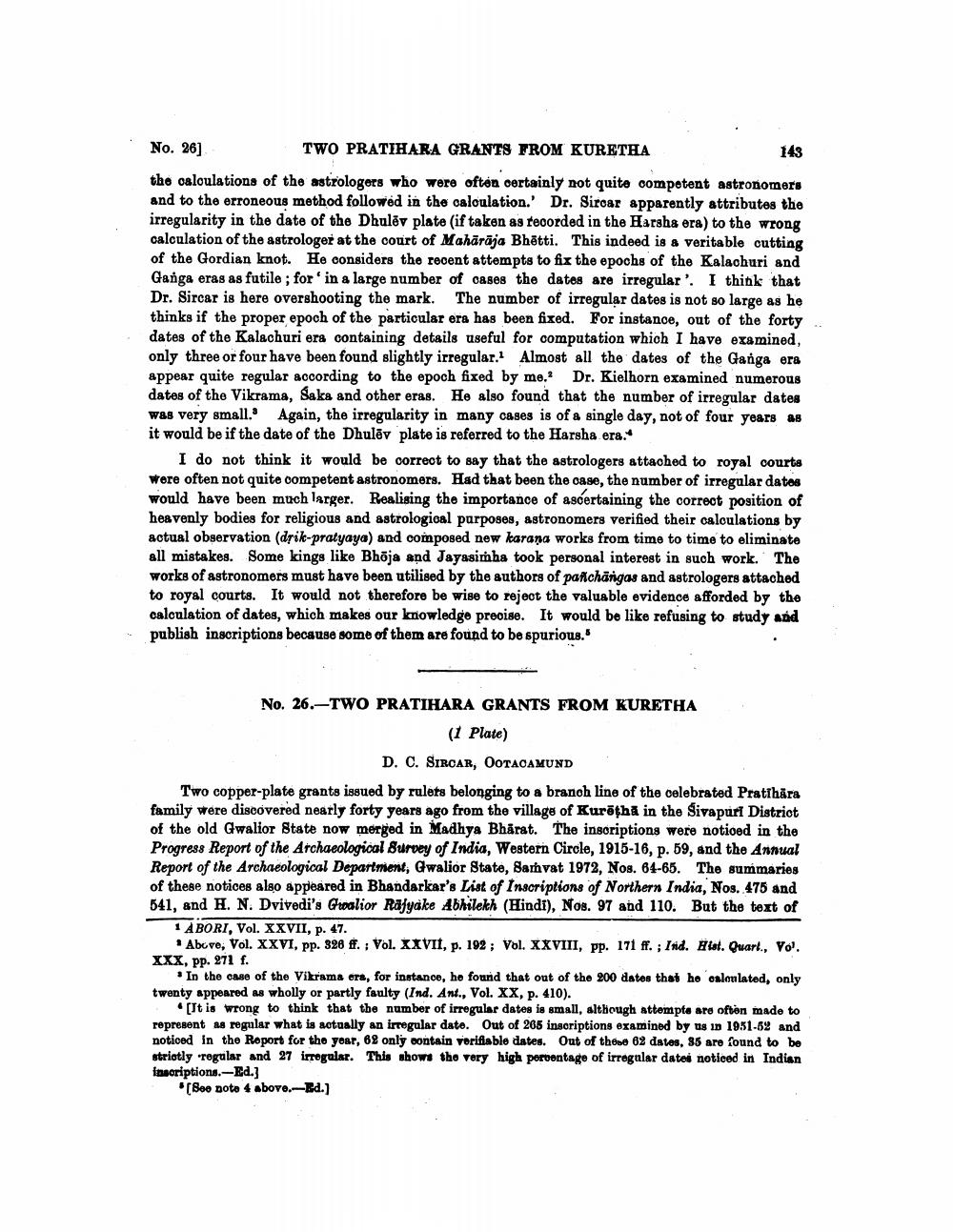________________
No. 26] TWO PRATIHARA GRANTS FROM KURETHA
143 the caloulations of the astrologers who were often certainly not quite competent astronomers and to the erroneous method followed in the caloulation. Dr. Siroar apparently attributes the irregularity in the date of the Dhulēv plate (if taken as recorded in the Harsha era) to the wrong calculation of the astrologer at the court of Mahārāja Bhētti. This indeed is a veritable cutting of the Gordian knot. He considers the recent attempts to fix the epochs of the Kalachuri and Ganga eras as futile ; for in a large number of cases the datos are irregular'. I think that Dr. Sircar is here overshooting the mark. The number of irregular dates is not so large as he thinks if the proper epoch of the particular era has been fixed. For instance, out of the forty dates of the Kalachuri era containing details useful for computation which I have examined, only three or four have been found slightly irregular. Almost all the dates of the Ganga era appear quite regular according to the epoch fixed by me. Dr. Kielhorn examined numerous dates of the Vikrama, Saka and other eras. He also found that the number of irregular dates Wag very small. Again, the irregularity in many cases is of a single day, not of four years as it would be if the date of the Dhulēv plate is referred to the Harsha era.
I do not think it would be correct to say that the astrologers attached to royal courts wore often not quite competent astronomers. Had that been the case, the number of irregular datos would have been much larger. Realising the importance of ascertaining the correct position of heavenly bodies for religious and astrological purposes, astronomers verified their calculations by actual observation (dgik-pratyaya) and composed new karana works from time to time to eliminate all mistakes. Some kings like Bhõja and Jayasimha took personal interest in such work. The works of astronomers must have been utilised by the authors of pafchärigas and astrologers attached to royal courts. It would not therefore be wise to reject the valuable evidence afforded by the calculation of dates, which makes our knowledge preoise. It would be like refusing to study and publish inscriptions because some of them are found to be spurious.
No. 26.-TWO PRATIHARA GRANTS FROM KURETHA
(1 Plate)
D. C. SIRCAR, OOTACAMUND Two copper-plate grants issued by rulets belonging to a branch line of the celebrated Prathara family were discovered nearly forty years ago from the village of Kuritha in the Sivapuri District of the old Gwalior State now merged in Madhya Bharat. The insoriptions were notioed in the Progress Report of the Archaeological Survey of India, Western Circle, 1915-16, p. 59, and the Annual Report of the Archaeological Department, Gwalior State, Samvat 1972, Nos. 64-65. The summaries of these notices also appeared in Bhandarkar's List of Inscriptions of Northern India. Nos. 475 and 541, and H. N. Dvivedi's Groalior Rajyake Abhilekh (Hindi), Nos. 97 and 110. But the text of
1 ABORI, Vol. XXVII, p. 47.
* Above, Vol. XXVI, pp. 320.; Vol. XXVII, p. 192; Vol. XXVIII, pp. 171 ff.; Ind. Hist. Quart., Vol. XXX, pp. 271 f.
. In the case of the Vikrama ora, for instance, he found that out of the 200 dates that he onlonlated, only twenty appeared as wholly or partly faulty (Ind. Ant., Vol. XX, p. 410).
It is wrong to think that the number of irregular dates is small, although attempts are often made to represent as regular what is actually an irregular date. Out of 205 inscriptions examined by us in 1951-62 and noticed in the Roport for the year, 69 only contain verifiable dates. Out of these 62 dates, 85 are found to be strictly regular and 27 irregular. This shows the very high porvontage of irregular dates noticed in Indian inscriptions.-Ed.]
[800 noto 4 sbove.-Bd.]




